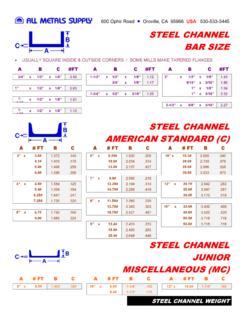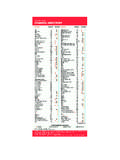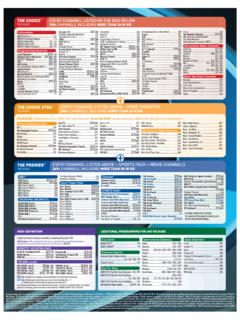Transcription of The Handbook of Channel Marketing - elew.com
1 The Handbook of Channel Marketing How to select, motivate, and manage the people and organizations who sell your goods and services: Direct, Distributor, OEM, VAR, Systems Integrator, Rep, Retail by Edwin Lee E-mail: Innovators and early-adopters edition 1995, 1996 by Edwin Lee, All Rights Reserved No part of this book may be reproduced in any form or by any means without the express written permission of the copyright holder. To Arnold Jorgensen An engineering craftsman, a recreational adventurer, my mentor, and my friend. i ii Thanks Thanks to Rich McClellan, Mike Campo, Jack Blakemore, Jeff Blackden, Larry Reierson, Jeff Miller, George Satterthwaite, Peter Benedikt, Ted Lusk, and Bruce Michels for diligently reviewing early drafts of the book and for providing me with so many helpful comments and suggestions on how to improve it.
2 Thanks to Tom McCall, Brad Paul, Dave Paul, Bob Dietz, Tom Eisenstadt, George Rozzaza, Ron Ferara, Jerry Horrowitz, Pete Rocco, Rich Kelliher, Dennis Jordan, Ken Ericksen, Kathy Ericksen, Mary Pim, and many others for sharing so generously about their Sales Representative, Distributor, and VAR businesses, and for their many encouragements. A special thanks to Bob Dietz, founder of the Association of High Technology Distributors. He enabled me to join that organization and to experience the world of hi-tech selling from the perspectives of its members. A singular thanks to my mother, Betty Lee, who has rigorously edited this book twice; enthusiastically correcting her son s occasional misuses of the king s English. Any mistakes that you find were probably created after she finished editing. Rev: November 10, 1997 iii iv Table of Contents Table of Author s Who can use this book?
3 4 Section I: Methods and Tools 1. Defining the What is a Marketing System?..9 When is it Successful?..10 The Six Cornerstones of successful business 2. How to Produce the The learning process: through complexity to The Scientific Method: our problem solving Commentary on the Using it to design and manage a Marketing Short 3. How to Motivate and Manage Maslow s Hierarchy of Personal Needs ..27 The need for Management by Personal A Personal Attractor s Money and Personal Competitive The Principle of Three to Reasons to manage by Personal The bottom 4. Decision-making Adventurers ..41 Bureaucrats ..44 Victims ..45 v Other Market timing for Adventurers, Craftspeople, and Impact on selling ..46 5. Customers Buying The buying The buying process ..50 Shortcuts in the buying Timing of the buying What customers want or Timing of goods and 6.
4 Customer/Supplier Relative importance of Customers and Critique of the Customer is King ..67 The desired outcome: Profitable 68 The bottom 7. Manufacturers Selling Selling Timing of the selling Section II: Channel Organizations 8. Introduction to Sales Manufacturers Value Added Other Channel Classifying organizations is 9. Direct Key Management Best Worst vi 10. Manufacturers Key Working Management Best Worst 11. Key Working Management Best Worst 12. Shelf Key Product Management Best Worst 13. Value Added Structures ..123 Key Working Management Best Worst vii Section III: Where the Rubber Meets the Road 14. How to Design Your Marketing Where we are in the design Simplifying Principle # Simplifying Principle # Eight Questions that shape your Marketing System.
5 133 Summary of values added by Channel How to develop a Marketing system from How to optimize an existing system ..142 Guidelines for adding 15. How to Hire Sales Professionals and Channel General Interview and hiring Interviewing Sales Interviewing Reps or Use the old-boy Eight common 16. How to Get Them to Sell for Plan Plan Plan First training 17. Eight ways to Keep them Selling for You ..159 1. Provide dependable, timely 2. Build on 3. Have the best sales professionals visit the 4. Publicize competitive ratings among top performers..162 5. Conduct participative and interactive sales 6. Establish a Top Sales Professionals 7. Establish a Council of Channel 164 8. Establish an effective and continuous training 18. A Fresh Look at Classic What makes the Sales Forecast Individual Quotas and Launching New 19.
6 Automating Your Marketing Examples of effective Eight tips on how to automate ..174 Suggestions for computer-resistant 177 viii 20. Those Nasty, One-sided Principles of Elements of Channel Objectives of Channel Usual signing Suggested signing procedure ..183 Sales Representative Distributor and VAR 21. Managing Channel Examples of Origins of How to manage 22. Seven Ways a CEO Can Increase 1. Visit customers and Channel 201 2. Require other corporate executives to visit the 3. Actively and formally listen to sales professionals ..204 4. Convey personal thanks to top performers .. 204 5. Review Channel agreements and how they are 6. Replace win-lose forecasting with proactive planning ..205 7. Sponsor an ongoing sales-training program ..205 Appendix A Recommended Sales and Menu of Services, M&D Controls Company Essays Do You Compete With or Compete Against?
7 Effective and Meaningful Jobs The Computer as God? ix x Author s Foreword Thirty years of personal experience led to this book. So did the help and support of many people, including sales and Marketing professionals from all over the country. This is the book we needed when a group of us, technologists all, started our first company. I am an engineer and an entrepreneur who learned how to market and sell as the need arose. I founded two successful high-tech companies and two other learning experiences. The successful companies are Pro-Log Corporation, which makes industrial computers, and MSI Data Corporation, which made order entry systems. The other learning experiences were Drag Mag, a toy company, and Digital Devices, maker of test equipment for capacitors.
8 Digital Devices was my first entrepreneurial endeavor. In the early 1960s, we four engineers worked nights and weekends out of a garage, while employed full-time at a computer company. I had designed a piece of test equipment that no one else had been able to make, and we learned the hard way that the world market for our $5000 instrument was 30 units. After two years of hard work at no pay, we sold three units, broke even, cleaned out the garage, and resumed a more normal existence. Several years later, two of us from Digital Devices teamed up with a third person and started MSI Data Corporation. This time we identified a sizable market first: the supermarket industry. Then we found a product it needed in large quantities: order entry systems which supermarkets used to order groceries from their wholesalers via the telephone.
9 Then we designed and sold the product. I was the VP of Engineering. I led product development, helped close the initial sales, found the SBIC (Small Business Investment Corporation) that financed us, and established our nationwide field service organization. MSI was very successful for a few years, went public, and was eventually acquired by a competitor. However, the three of us who founded it disagreed strongly among ourselves about how to run a company, so I left after three years and a second founder left a year later. Mine wasn t a happy departure, but in retrospect it was a blessing. I had neglected my family, and a period of rest reestablished my perspective about what was most valuable to me. A year after leaving MSI, I founded, and was President, of an ill-fated toy company: Drag Mag. During its brief existence, we made a toy product, test-marketed it in Bakersfield, advertised it on TV in the Los Angeles market, and sold it through retail channels, including Toys-R-Us.
10 Then, in late 1972, Matt Biewer and I founded Pro-Log. I was its CEO for the next sixteen years. We started Pro-Log with $150,000 of our own money and a commitment to grow the business entirely from profits. We also vowed to make it an enjoyable place to work, a place that supported family life. Matt had six children; I had five. In August of 1973 we moved Pro-Log from Southern California to the Monterey Peninsula, and proceeded to grow, prosper, and enjoy our families for the next ten years. During Pro-Log s first five years I personally developed and managed its sales organization. We sold PROM Programmers and board level microcomputers through two domestic channels: Direct Sales and Manufacturers Representatives. Internationally, we sold through Distributors. In later years we added Distributors and a few VARs to the domestic organization.







